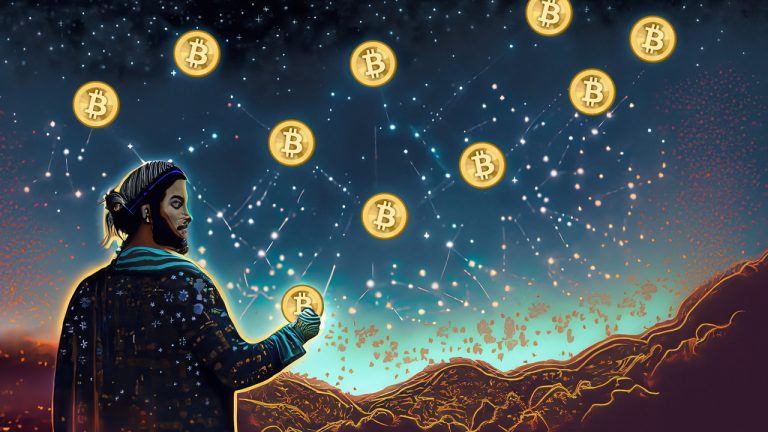Charting Bitcoin’s Predictable Course: A Comprehensive Review of the Next 29 Reward Halvings
Publikováno: 22.7.2023
 In under 280 days, Bitcoin’s blockchain will undergo its fourth reward halving event, slicing the block subsidy from 6.25 BTC to 3.125 BTC. The crypto community is abuzz with chatter, contemplating how these substantial decreases in block rewards will transpire over the ensuing two decades, and speculating on how miners will cope with the impending […]
In under 280 days, Bitcoin’s blockchain will undergo its fourth reward halving event, slicing the block subsidy from 6.25 BTC to 3.125 BTC. The crypto community is abuzz with chatter, contemplating how these substantial decreases in block rewards will transpire over the ensuing two decades, and speculating on how miners will cope with the impending […]

In under 280 days, Bitcoin’s blockchain will undergo its fourth reward halving event, slicing the block subsidy from 6.25 BTC to 3.125 BTC. The crypto community is abuzz with chatter, contemplating how these substantial decreases in block rewards will transpire over the ensuing two decades, and speculating on how miners will cope with the impending reductions. The following is a glimpse at the timeline of these subsidy transformations and a projection of the future rewards in the distant horizon.
From 50 to 1 Satoshi — Decoding Bitcoin’s Future Block Subsidy
A fortnight ago, Bitcoin.com News explored the looming Bitcoin halving and examined how bitcoin (BTC) miners will need to rely on a blend of inflated BTC prices and transaction fees to withstand their revenue being cut in half. At present, we’re left to scrutinize past block reward halvings and theorize about future ones, since the exact unfolding of events remains a mystery.
Yet, thanks to Bitcoin’s structured and predictable design, the community has a fair estimate of the timing for each halving. Following the upcoming halving set for April 2024, the subsequent event in 2028 will further whittle down the reward to a scant 1.5625 BTC. The quadrennial span succeeding the 2028 halving will witness the final block rewards exceeding a single BTC.
The 2032 halving will dwindle the block reward subsidy from 1.5625 BTC to a mere 0.78125. Post the 2028 halving, Bitcoin’s annual inflation rate will hover around 0.41%, and by 2032, it will contract to 0.21%. Come 2036, the block reward will whittle down to less than half a coin, precisely 0.390625 BTC.
In the subsequent four-year period following 2036, the reward will remain above a quarter coin, but by 2040, it will diminish to a lean 0.1953125 BTC. The block reward will hover above 0.1 BTC for the ensuing four years, or 210,000 blocks, but will contract to 0.09765625 BTC by 2044. Beyond 2044, BTC will witness successive reward halvings in a host of years, extending from 2048 to 2136.

By the time we reach 2136, the block reward will have diminished to a solitary satoshi or 0.00000001. In a closed economy, where Bitcoin’s growth grinds to a halt, miners may grapple with significant challenges if adoption plateaus. This raises a pivotal question — Once the block subsidy is reduced down to a lone satoshi in 2136, what will serve as the incentive for miners to continue fortifying the blockchain’s security?
The prevailing theory posits that as Bitcoin garners broader acceptance and transaction demand surges, escalating transaction fees will offer an enticing incentive for miners, encouraging them to persevere in safeguarding the network despite dwindling block rewards.
To optimize their earnings, miners will most likely have to prioritize high-fee transactions. This sets up a finely balanced dynamic, and it’s still uncertain how the network will adapt as block rewards progressively diminish. Every halving witnessed so far has placed miners under scrutiny, and each forthcoming halving will amplify the pressure on mining participants substantially.
Top 10 Countries’ Real-Time Transactions Could Net Bitcoin Miners $89 Billion a Year
Some argue that this theory relies significantly on the burgeoning adoption of peer-to-peer (P2P) transactions, as a stagnant, closed-loop economy burdened with high fees could potentially buckle under its weight. Should adoption proliferate to billions of users within a globe inhabited by eight billion individuals, onchain fees, even if nominal, could offer miners a substantial reward.
For instance, the leading ten nations clocked a combined total of 118.3 billion real-time payment transactions in 2021, averaging a staggering 324.4 million transactions per day (tpd). If the Bitcoin blockchain could stretch its scaling capabilities to manage 324.4 million tpd with a median fee of $0.76 per transfer, miners could rake in a windfall of $246,544,000 daily.
As it stands, miners accrued approximately $27.67 million in revenue on July 20, 2023, from the daily block reward and fees on BTC transactions. The record high for daily mining revenue in the year was $35.35 million on May 12, 2023. Consequently, a hypothetical daily profit of $246 million from fees would far outstrip current miners’ earnings.
What do you think about the future halvings and the challenges bitcoin miners may face? Share your thoughts and opinions about this subject in the comments section below.